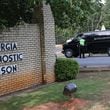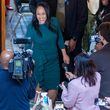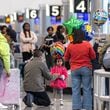MIAMI — One night in July, two men seeking revenge drove past a Brownsville home and fired indiscriminately into a group of people, including some just back from a trip to the local flea market. When the shooting stopped, a young child was dead and her baby cousin was injured. Two adults also suffered gunshot wounds.
The death of 7-year-old Alana Washington — a “sweet and strong-willed child” who attended KIPP Miami charter school in Northwest Miami-Dade — shocked family, friends, the community and law enforcement. Six weeks later, after an intense search, police arrested two men and charged them with killing Alana.
The young girl’s violent death was part of a sharp increase in murders in Miami-Dade County in 2020, a year upended by the coronavirus pandemic that saw kids home from school, parents losing jobs and social justice protests heightening tensions between the community and police.
Officials recorded 272 homicides through Dec. 24 across Miami-Dade County, up 31 cases from all of 2019, records show. The year isn’t even over and it’s a recent high — up from 232 in all of 2017, and 252 in 2015.
Experts attribute the rise in violent crime to several factors: The pandemic has limited community policing and cut back on positive interaction between police and the public. Gun sales are through the roof. People are stuck at home and frustrated. Kids aren’t in school. The economy has tanked. And some of us just don’t like each other.
“I’m not going to blame it on COVID, but it’s a big part of it. Beefs are being settled in the streets with gun violence, which is disturbing. It’s more brazen. Some shootings are in broad daylight. Being home is part of the problem,” said Miami-Dade Police Director Alfredo “Freddy” Ramirez. “Across the county, we’re seeing a spike. We’ve been cooped up for nine months. Our way of life has changed. And there’s always a tipping point.”
But to those suffering from the gunfire, the reasons don’t matter much. Their loved ones are lost forever. Alana’s mother Shanlavie “Niecey” Drayton, said the holidays have been particularly hard and that Alana’s twin brother, Aaden, though getting help, is still confused about what happened.
“It’s worse during the holidays. It doesn’t feel normal. She was only seven. How am I supposed to deal with it?” Drayton asked. “He’s [Alana’s brother] used to having someone with him. Aaden is in therapy and getting lots of love.”
It’s not just murders by gunfire. The number of people who have been shot but survived is also up. As of Dec. 7 in unincorporated Miami-Dade, which covers roughly 1.2 million people, 311 people have been injured by gunfire — an increase of 16% from the previous year.
“It’s happening in every city and it’s happening at the same time,” said Alex Piquera, who heads up the sociology department at the University of Miami and studies crime trends. “Isolating the one thing causing it is impossible. I’ve never seen anything like this. Guns and drug sales don’t go away. But now you have the added stress of anxiety and police not patrolling the way they have in the past. Kids are at home or on the street, they’re not necessarily in class.”
Most of the shootings in unincorporated Miami-Dade have taken place in the north or southern ends of the county. The most southern section of unincorporated Miami-Dade has been hit particularly hard, with 40 shooting deaths and 115 people being injured by gunfire, significant increases from 2019.
Miami-Dade Police Maj. Shawn Browne, who oversees the south district, said the youth have suffered, in part, because the county was forced to cut back on community policing when the pandemic took hold back in March. He said though the department has deployed more cops in the area, a mentoring program in which cops spent time with troubled youth basically came to a halt.
“Normally we would have officers taking kids to different events,” Browne said. “But because of COVID, we’re more restricted. Now they occasionally contact them [kids], just checking to see how they’re doing.”
The toll of the violence has been particularly jarring among young people. Medical examiner records show 62 homicides of people ages 21 and under. Besides Alana, a slew of children died in violent, high-profile cases.
Among them: Alejandro Ripley, 9, a nonverbal autistic child who drowned when police say his mother pushed him into a West Miami-Dade canal; 7-year-old Hezekiah Mucherson, shot and killed alongside his father in Miami Gardens; and newborn Ke’lani Brown, who died after his mother was shot and wounded in the head in Northwest Miami-Dade.
Another newborn, Andrew Caballeiro, is presumed dead after his father fatally shot three family members in Southwest Miami-Dade in January, then killed himself after driving upstate north of Tampa. Police searched rural areas across Southwest Florida, but his body has yet to be found.
Accidental shootings among young people have also taken a toll. At least three teens across Miami-Dade were shot and killed in separate incidents involving youths playing with guns. In another incident in South Miami-Dade, two teens and a 9-year-old boy were shot and wounded in an incident that police also deemed an accident.
At a gathering at Miami-Dade police headquarters a few weeks ago to address the increase in shootings, the brass were adamant that the increased violence had little to do with fights over drugs. Like the April shooting death of high school senior Andrea Camps who was shot near a home at Southwest 270th Street and 127th Avenue. Andrea and her boyfriend were lured there, police said, on social media by someone claiming to be selling shoes. Her boyfriend, shot too, survived.
“It’s not drugs,” said Miami-Dade Homicide Maj. Jorge Aguilar. “It’s usually just retaliation over something as simple as a beef on social media.”
But many times, motives for the violence aren’t very clear to police.
In late May, an electronic sound detection device called Shot Spotter that picks up gunfire recorded what sounded like a war zone: 34 shots erupted outside a convenience store on the 2600 block of Northwest 95th Street. Surveillance footage showed a group of men talking for an hour outside the store. Moments later, as two of the men got back into a Nissan Maxima, a frantic gun battle broke out. At least four men fired weapons. Four were wounded.
What exactly spurred the gunfire remains unknown to investigators. One man was charged with attempted murder: Lawrence Miles-Trice, 34, who later showed up at Jackson Memorial Hospital with his own gunshot wound.
In other cases, just being home day after day during the pandemic has led to confrontations.
Just last month a suspected burglar named Anthony Arias tried breaking into a West Miami-Dade house — while a teenage student was home taking an online class. The student called his father, who happened to be an off-duty Miami police officer. When he showed up he shot the screwdriver-wielding man to death in the driveway.
Then there is the case of Carthoris Jenkins, who was inside his North Miami-Dade efficiency three weeks ago playing video games when a burglar tried breaking in. Instead of calling 911, detectives said, Jenkins chased the man down the block and shot him point-blank as the man kneeled on the ground begging for his life. Jenkins, who claimed in court that he was the victim, is awaiting trial for attempted murder.
The Miami-Dade Police department, which investigates killings in unincorporated sections of the county as well as a host of smaller cities, has the biggest uptick of homicide cases: 147 through Dec. 24, up from 129 last year, records show.
City by city, the numbers fluctuated.
Through Dec. 18 this year, according to numbers supplied by Miami Police, the city has experienced 62 homicides, 47 of them the result of gunfire. Through the same date in 2019, the total number of homicides in the city, which includes gunfire deaths and other methods of murder like stabbings and suffocation, a total of 48 were killed.
Miami, the county’s largest municipality, also recorded 130 contact shootings so far this year, compared to 125 a year ago.
Miami Police Chief Jorge Colina attributed the spike — which was preceded by years of historically low homicide numbers in the city — to a number of factors that include less use of federal partners in high-crime areas and cutting down on what had been a rigorous community policing effort as officers are forced to work pandemic duty details.
“Longer-term investigations of crime have been curtailed. And our problem-solving teams spent the first three months of the pandemic dealing with protests,” Colina said. “We’ve tried to do things virtually with kids, but there’s just not the same amount of participation. Events like barbecues, music, or field trips to ballgames have been cut back. It just hasn’t been the same.”
Homicides in Miami Gardens dropped from 26 in 2019 to 18 through Dec. 21 of this year. And Miami Beach saw an overall drop in major crimes like murder, rape and aggravated assault of 29%.
Miami Beach Police Chief Richard Clements attributed the drop in major crimes to fewer tourists in town and curfews, and to cops “identifying crime trends and reallocating our staffing to key areas.” Through Thursday, the Beach had recorded four homicides, down from six last year.
“These measures, coupled with fewer tourists and the emergency orders [like a midnight curfew] in place due to the pandemic, have contributed to the reduction in crime,” Clements said.
The jump in shooting deaths in Miami and Miami-Dade reverses a two-decade trend that saw the murder rate reach historic lows. And though major crime numbers locally have risen significantly, they’re still well below skyrocketing rates in 51 major cities across the country that have jumped by an average of 36%, according to a recent study by crime analyst Jeff Asher.
Asher’s study, completed in September and written about in the New York Times determined that the murder rate in St. Louis could increase this year by as much as 90%. While Baltimore, Detroit and New Orleans were all expected to almost double.
Another reason for the jump in contact shootings and murders, police say, is that gun sales have skyrocketed. The National Shooting Sports Foundation said in November that gun sales were expected to easily eclipse the record 15.7 million guns sold in 2016. Leading the way, according to the foundation, are first-time gun-buyers, particularly African Americans and women.
It’s not unusual for gun sales to surge in an election year when a Democrat wins the presidency and citizens fear their guns will be taken away. But add to that skittish residents stuck mostly at home during the pandemic and people frightened by this summer’s heated protests and it isn’t surprising that gun sales have taken off.
And, says “Niecey” Drayton, who lost her young daughter to gunfire earlier this year, there are far too many weapons in the hands of youths.
“They don’t have anything else better to do,” she said. “When we were young, there were summer programs. They’re just out there now, doing whatever.”
About the Author





